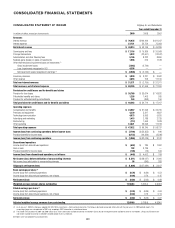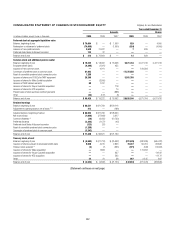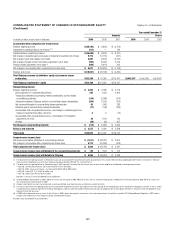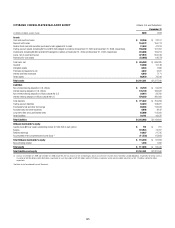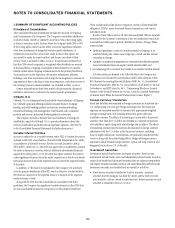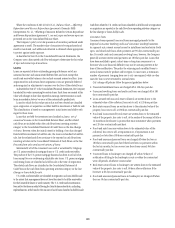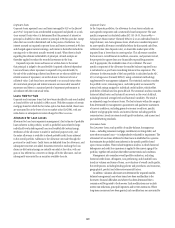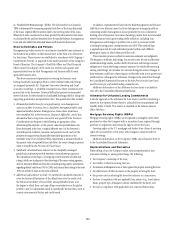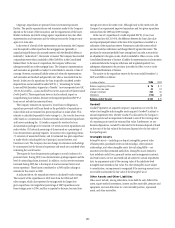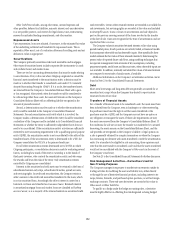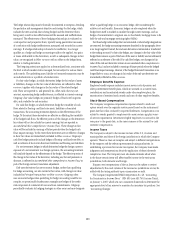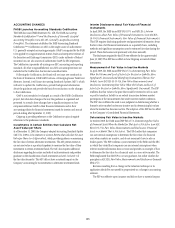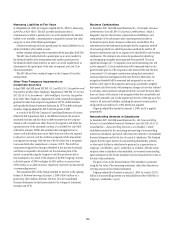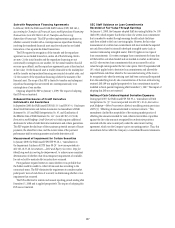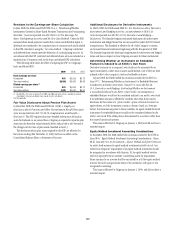Citibank 2009 Annual Report Download - page 140
Download and view the complete annual report
Please find page 140 of the 2009 Citibank annual report below. You can navigate through the pages in the report by either clicking on the pages listed below, or by using the keyword search tool below to find specific information within the annual report.130
as “Troubled Debt Restructurings” (TDRs). The allowance for loan losses for
TDRs is determined by comparing expected cash flows of the loans discounted
at the loans’ original effective interest rates to the carrying value of the loans.
Where short-term concessions have been granted, the allowance for loan losses
is calculated by the analyses described above for smaller-balance, homogeneous
loans and also reflects the estimated future credit losses for those loans.
Reserve Estimates and Policies
Management provides reserves for an estimate of probable losses inherent in
the funded loan portfolio on the balance sheet in the form of an allowance
for loan losses. These reserves are established in accordance with Citigroup’s
Credit Reserve Policies, as approved by the Audit Committee of the Company’s
Board of Directors. The Company’s Chief Risk Officer and Chief Financial
Officer review the adequacy of the credit loss reserves each quarter with
representatives from the Risk Management and Finance staffs for each
applicable business area.
The above-mentioned representatives covering the business areas
having classifiably managed portfolios, where internal credit-risk ratings
are assigned (primarily ICG, Regional Consumer Banking and Local
Consumer Lending), or modified consumer loans, where concessions were
granted due to the borrowers’ financial difficulties present recommended
reserve balances for their funded and unfunded lending portfolios along with
supporting quantitative and qualitative data. The quantitative data include:
Estimated probable losses for non-performing, non-homogeneous •
exposures within a business line’s classifiably managed portfolio and
impaired smaller-balance homogeneous loans whose terms have
been modified due to the borrowers’ financial difficulties, and it was
determined that a long-term concession was granted to the borrower.
Consideration may be given to the following, as appropriate, when
determining this estimate: (i) the present value of expected future cash
flows discounted at the loan’s original effective rate; (ii) the borrower’s
overall financial condition, resources and payment record; and (iii) the
prospects for support from financially responsible guarantors or the
realizable value of any collateral. When impairment is measured based on
the present value of expected future cash flows, the entire change in present
value is recorded in the Provision for loan losses.
Statistically calculated losses inherent in the classifiably managed •
portfolio for performing and de minimis non-performing exposures.
The calculation is based upon: (i) Citigroup’s internal system of credit-risk
ratings, which are analogous to the risk ratings of the major rating agencies;
and (ii) historical default and loss data, including rating-agency information
regarding default rates from 1983 to 2008, and internal data dating to the early
1970s on severity of losses in the event of default.
Additional adjustments include• : (i) statistically calculated estimates to
cover the historical fluctuation of the default rates over the credit cycle,
the historical variability of loss severity among defaulted loans, and
the degree to which there are large obligor concentrations in the global
portfolio; and (ii) adjustments made for specifically known items, such as
current environmental factors and credit trends.
In addition, representatives from both the Risk Management and Finance
staffs that cover business areas that have delinquency-managed portfolios
containing smaller homogeneous loans (primarily the non-commercial
lending areas of Regional Consumer Banking) present their recommended
reserve balances based upon leading credit indicators, including loan
delinquencies and changes in portfolio size as well as economic trends
including housing prices, unemployment and GDP. This methodology
is applied separately for each individual product within each different
geographic region in which these portfolios exist.
This evaluation process is subject to numerous estimates and judgments.
The frequency of default, risk ratings, loss recovery rates, the size and diversity
of individual large credits, and the ability of borrowers with foreign currency
obligations to obtain the foreign currency necessary for orderly debt servicing,
among other things, are all taken into account during this review. Changes in
these estimates could have a direct impact on the credit costs in any quarter and
could result in a change in the allowance. Changes to the reserve flow through
the Consolidated Statement of Income on the lines Provision for loan losses
and Provision for unfunded lending commitments.
Additional information on the allowance for loan losses is included in
Note 18 to the Consolidated Financial Statements.
Allowance for Unfunded Lending Commitments
A similar approach to the allowance for loan losses is used for calculating a
reserve for the expected losses related to unfunded loan commitments and
standby letters of credit. This reserve is classified on the balance sheet in
Other liabilities.
Mortgage Servicing Rights (MSRs)
Mortgage servicing rights (MSRs) are recognized as intangible assets when
purchased or when the Company sells or securitizes loans acquired through
purchase or origination and retains the right to service the loans.
Servicing rights in the U.S. mortgage and student loan classes of servicing
rights are accounted for at fair value, with changes in value recorded in
current earnings.
Additional information on the Company’s MSRs can be found in Note 23
to the Consolidated Financial Statements.
Representations and Warranties
When selling a loan, the Company makes various representations and
warranties relating to, among other things, the following:
• the Company’s ownership of the loan;
• the validity of the lien securing the loan;
• the absence of delinquent taxes or liens against the property securing the loan;
• the effectiveness of title insurance on the property securing the loan;
• the process used in selecting the loans for inclusion in a transaction;
• the loan’s compliance with any applicable loan criteria (e.g., loan balance
limits, property type, delinquency status) established by the buyer; and
• the loan’s compliance with applicable local, state and federal laws.


